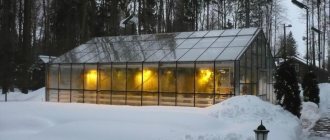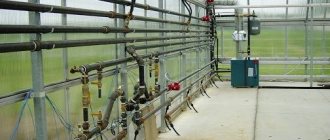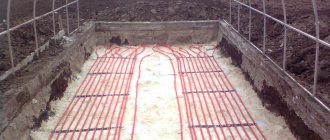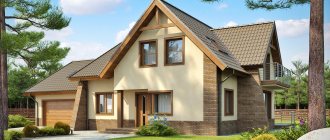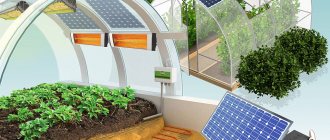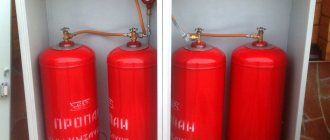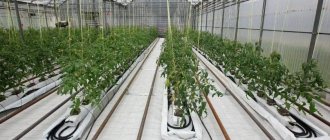A popular way to heat greenhouses is to use heat from burning gas.
A gas heater for a greenhouse will provide the seedlings with the necessary heat, allowing you to start heating as soon as necessary. It gained popularity due to its portability and relative cheapness, thanks to which even the seasonal use of a personal plot does not become a significant shock to the family budget. In order to fully enjoy the benefits of a gas heating system, you should study all the technical nuances of structures of this kind.
How to make gas heating for a greenhouse
Only a properly selected gas heater will cope with the task. The first classification system is based on the use of a water or gas-air heating unit. In the second case, warm air moves in special air ducts. Another classification system is based on the number of built-in heat sources.
For small greenhouses, a 1-phase is suitable, and for larger ones, a multi-phase greenhouse heater is suitable. If we talk about the advantages of both options, then it is preferable to choose the second one.
This is explained as follows:
- Small heat sources are installed along the entire perimeter of the building, which promotes uniform heating;
- If the region experiences sudden cold snaps, then the multiphase version of the heater is supplemented with a catalyst system;
- An IR heater will help smooth out high humidity and a high difference between night and day temperatures.
The retail chain offers a large selection of gas heating devices for use in greenhouses. When choosing, you need to take into account the operating temperature range, humidity level, building area, and so on. The more accurately the calculation is carried out, the less wasteful expenses the gardener expects.
Water heating in a greenhouse
This method of heating a greenhouse is one of the most financially beneficial. You can easily make an electric water heater with your own hands. There are two ways to make such a device.
Method 1
- You need to find the body of an unnecessary old fire extinguisher with the top cut off.
- Take a 1 kW heating element from an old electric samovar, which must be mounted on the bottom of the fire extinguisher body.
- A lid is attached to the body of a homemade electric heater so that water can be poured into it.
- The heater is equipped with two water pipes connected to the radiator. Pipes must be connected using gaskets and nuts to prevent water leakage.
To automate the heater, it is best to use an alternating current relay, for example MKU-48, with a voltage of 220V. When the temperature sensor is triggered, the contacts (K1) will close and the heater will begin to heat the water, which, therefore, will heat the air in the greenhouse. When the water temperature in the electric heater reaches the set level, the temperature sensor will work again, the power supply circuit of the relay (K1) will break, and the electric heater will turn off. If it is not possible to purchase an MKU-48 relay, you can use the second scheme, where the relay has contacts that do not pass a current of less than 5A.
Method 2
For the second method you will need several old pipes, a heating element and a welding machine. Everything is produced quickly and reliably.
- A boiler with a capacity of at least 50 liters with a 2 kW electric heater is installed in a suitable corner of the greenhouse. During the heating process, water will be supplied through the expansion tank to the heating system distributed around the perimeter of the greenhouse. The heating system pipes should have a slight downward slope.
- The boiler is made from a piece of large diameter pipe onto which a bottom with a flange is welded.
- The heating elements are connected to each other by an electrical cord with a plug, which must be well insulated.
- The connection between the flange and the body must be sealed with a rubber gasket.
- The expansion tank is also made from pipe scraps. It must have a volume of at least 30 liters. Couplings are welded at the bottom of the tank and at its two ends, which connect it to the boiler riser and the system.
- A lid is attached to the tank to allow water to be added so that its level can be periodically monitored.
- A pipeline is made from metal pipes, the ends of which are pre-threaded for easy connection to the system.
- To ground the boiler body, a flexible three-core copper wire is used, capable of withstanding voltages above 500V without insulation. Two grounding conductors are attached to the phases of the heating element, and the third is attached to the boiler body.
In winter, for better heat retention, it will be possible to install special screens made of heat-reflecting material, such as foil, or another.
The main condition for installing any heating system in greenhouses is strict adherence to safety precautions, as well as following instructions. Only in this case will your efforts be crowned with success!
Tips for beginning gardeners: how to install gas into a greenhouse
Lucky are those whose greenhouse is located in close proximity to their home. In this case, you can heat the seedlings with gas with minimal time and effort. The situation is more complicated when it is impossible to install a gas pipeline to the greenhouse.
Mobile sources of gas - cylinders - will help to get out of this situation. Our review will help you choose a gas heater: https://homeli.ru/stroitelstvo-doma/inzhenernye-sistemy/otoplenie/gazovye-obogrevateli. When using them, you must always monitor the concentration of carbon dioxide in the greenhouse.
If there is too much of it or vice versa, the seedlings will not grow. You can assemble the simplest gas circuit as follows. First, you need to decide whether gas will be supplied to the house and greenhouse, or whether you plan to heat only the seedlings.
In the second case, the heat supply diagram looks like this:
- Gas sources;
- Heat exchanger;
- Fan;
- Air duct for constant exchange of hot and cold air masses;
- Buffer – equalizing pressure;
- Exhaust gas outlet source.
Depending on the distance of the house from the greenhouse, the gardener chooses one of two methods of supplying a heat source. In the first case, we are talking about direct connection by pipeline, and in the second, about the use of gas cylinders. In order for heating to be as efficient as possible, gas heating is supplied with the obligatory presence of a reverse circuit. Its presence does not allow carbon dioxide to accumulate inside the greenhouse, and also reduces the likelihood of an emergency situation.
Safety precautions when connecting gas
If it was decided to use gas cylinders for heating the greenhouse, safety precautions must be observed when connecting them to devices:
- After connecting the cylinder through the reducer to the equipment and securing the clamps, check for leaks. To do this, cover all connections with soap foam (any kind will do). If the formation of bubbles is observed, then there is a leak, and therefore it is necessary to tighten all connections again and carry out the control act again.
- Place the gas cylinder 1 m away from the heating device.
- Do not check the tightness of connections using burning paper or similar tricks.
- When filling a cylinder, the volume of gas in the container should not exceed 85% of the total in order to avoid an increase in internal pressure.
Gas heating in greenhouses today is an affordable and economical heating option, allowing you to obtain crops all year round. The main thing is to choose the right equipment and observe safety measures during its subsequent operation.
For heating greenhouses, many people prefer to use gas equipment. Gas heating of greenhouses has been developing quite intensively in recent years. This is mainly due to the emergence of new types of heaters: gas convectors and infrared burners.
Traditionally, heating a greenhouse with natural gas was considered not as “gas” itself, but as gas-water, i.e. consisting of a system of heating devices in which the heating medium - water - occurs in a gas heating boiler.
Universal gas gun for heating a greenhouse
The installation of a full-fledged gas-based heat supply system is not always justified. For example, seasonal greenhouses in temperate regions can be managed with the help of mobile portable devices.
Depending on the manufacturer, a heat gun has a power from 4.2 to 10 kW. When choosing a specific model, it is necessary to take into account the area of the building, otherwise increased consumption cannot be avoided. Read tips on choosing a heat gun in the material:
From an economic point of view, a heating system based on such guns is justified only in one case. If the device is used at least 10-15 times during the season, the purchase makes sense. The average gun has the following characteristics :
- Average gas consumption: 310-410 g/hour;
- Thermal energy generation: 33 – 50 kWh/m3;
- Heated area: 25 – 65 sq. m.;
- Working volume range: 10 – 25 l;
- Working pressure: 29-35 mbar.
The use of gas guns allows you to specifically heat a certain area of the greenhouse. Before you start using the device, it would be a good idea to study its technical characteristics. Increased attention is paid to fuel consumption and thermal coverage. Based on the study of the mentioned characteristics, a model is selected that allows economical heating of the greenhouse.
Pellet burner 50kW. Heating of greenhouse 350m2.
Reviews:
Dmitry Bespriyuty
writes: Leonid, greetings! How much does a reel like this cost and how long does one cast take?
Vasily Sannikov
writes: Average consumption 10kg/hour. How much does it warm up at this flow rate, what is the temperature outside?
Viktor At
writes: Good afternoon. What kind of pipe do you use for heating and what temperature do you give that turned them around like that?
Dmitry Bespriyuty
writes: Leonid, greetings! How much does a reel like this cost and how long does one cast take?
Vasily Sannikov
writes: Average consumption 10kg/hour. How much does it warm up at this flow rate, what is the temperature outside?
To heat a room with gas, you can use various heating equipment: gas burners or air heaters. Each of them has its own characteristics. The introduction of burners is no longer safe. But provided that there are no wood parts in the greenhouse design, you can resort to burners. In this case, the burners simply need to be connected to cylinders and placed throughout the entire area of the room that requires heating. Installing a heating system requires a lot of expense and effort, but this option will prove to be more convenient to use in the future.
Increased attention must be paid to the uniform distribution of heat in the room, because this represents the greatest difficulty when organizing gas heating. To do this, you need to connect a sufficient number of burners to the gas cylinder, which will be distributed evenly throughout the room. With all this, providing gas heating for a greenhouse requires compliance with certain safety measures. For example, access to gas burners should not be hampered in any way. If any problems occur in their operation, it should be possible to turn them off immediately. In addition, gas equipment requires constant preventive maintenance.
Rationalization ideas: how to heat a greenhouse without gas and electricity
Continuing the topic of saving, it is necessary to dwell on one more point. In some cases, heating can be carried out from natural heat sources. At the same time, electricity, water and gas are completely abandoned. One such example is the use of solar energy. At first glance it may seem that this is not entirely economical, but the secret of success lies in proper preparation.
Read more about alternative energy sources at the link:
The following recommendations will help you avoid common mistakes during the installation of solar panels:
- The panels are installed on the sunny side. Slopes are installed on the opposite side of the greenhouse. They play the role of a vehicle that transfers and dissipates heat so that heated seedlings do not experience temperature shock.
- An excess heat accumulator is built under the structure. Here it is important to emphasize that it is better to do the installation before the actual installation of the greenhouse.
- Air heating from a natural source reduces the economic component of the project. It must be remembered that it can only be used in certain months, depending on climatic conditions.
Solid fuel boiler for heating a greenhouse
The boiler is installed in or near the greenhouse, in a separate room. The second method is convenient because fuel can be added to the boiler without entering the greenhouse, and this retains such valuable heat in it. In addition, it saves space in the greenhouse. The disadvantage of this method is that the boiler itself heats up and becomes a source of heat, which is wasted if it is not in a greenhouse.
Fuel is added to the heat generator twice a day. This type of greenhouse heating is absolutely fireproof, so it can be left unattended without fear of fire. Fuel consumption with such heating is also minimal.
Economical gas heater for a greenhouse (video)
Heating for a greenhouse based on a gas cylinder is an opportunity to create comfortable conditions for seedlings in cases where electric or centralized heating cannot be supplied. Before installation, a project should be developed, taking into account the area of the structure, duration of operation and the nature of the planted crops. During direct installation, all manufacturer's recommendations must be strictly followed.
- Author: admin
Rate this article:
- 5
- 4
- 3
- 2
- 1
(1 vote, average: 5 out of 5)
Share with your friends!
Device for heating greenhouses and other premises
A device for heating greenhouses in automatic mode with increased safety.
A device for heating greenhouses and other premises is presented in the form of a catalytic air heater (KVH) - a gas air heater operating on natural or liquefied gas. Heated clean air is supplied directly to the room. The KVN includes a catalytic filter unit, which highly efficiently cleans hot air from harmful substances - fuel combustion products.
Buy product
Description
Advantages
Application
Specifications
Seasonal cost of heating greenhouses
Description:
A device for heating greenhouses and other premises is presented in the form of a catalytic air heater (KVH) - a gas air heater operating on natural or liquefied gas. Heated clean air is supplied directly to the room.
KVN consists of two independent blocks:
– direct heating gas air heater – a serially produced certified product,
– catalytic filter unit – a passive attachment to the air heater, does not affect the gas supply system, power supply, does not make changes to the automation and control systems. Carries out highly effective cleaning of hot air from harmful substances - fuel combustion products.
Advantages:
– automatic temperature maintenance in a heated room,
– ensuring increased safety due to the double valve,
– the air heater operates in automatic mode,
– does not require the constant presence of an operator,
– the safety system ensures automatic shutdown of the gas supply when: the air supply to the burner is stopped, the gas pressure at the inlet of the air heater drops below 0.8 kPa, the flame goes out, the power supply is cut off,
– the ability to operate the air heater in two modes: ventilation mode and heating mode,
– the presence of a light alarm when the operating modes of the air heater are violated.
Application:
– autonomous heating of greenhouses, livestock farms, storage facilities, hangars, production and auxiliary premises,
– use as a basic element of local heat supply for residential buildings and industrial buildings under construction.
Specifications:
| Characteristics: | Meaning: |
| Nominal performance, kW | 80 |
| Natural gas, nm3/hour | 8,2 |
| Propane, kg/hour | 5,4 |
| Gas connecting pressure, kPa | 2,0 |
| Air capacity, m3/hour | 5 000 |
| Rated electrical power consumption, W, no more | 400 |
| Supply voltage, 50 Hz, V | 380 |
| Overall dimensions (length x diameter), mm | 1 150 x 400 x 576 |
| Weight, kg | 45 |
| Efficiency,% | >96 |
* the concentration of harmful substances released during operation of the KVN-1 “EcoKat” is significantly lower than the MPC (maximum permissible concentrations)
Seasonal cost of heating greenhouses:
| KVN | Thermal energy from CHP | Diesel fuel heat guns |
| 500 – 600 actual costs) | 1 600 | 2 000 |
* in thousands of rubles
** based on the results of operating a greenhouse facility in Novosibirsk with a volume of heated greenhouses of 22,500 m3 (Novosibirsk).
Site Map
autonomous heating of hangarsautonomous heating of non-residential premisesautonomous heating of premisesautonomous heating of industrial premisesautonomous heating of greenhousesautonomous heating of farmscatalytic filter unitair heaters gas manufacturersair heaters gas industrial manufacturers rfair heater buyair heating of industrial premisesgas air heaters for homegas air heaters for productiongas air heater for air heating leniyagas air heater of mixing typecatalytic air heaterbuy air heatersgas local heat supplyheater for greenhouseheating of industrial premisesindustrial heating of buildings and premisesindustrial gas air heatersdirect air heatingheating systems for industrial premisesecologically friendly air heater 7012
Demand factor 218
comments powered by HyperComments
Greenhouse heating completed.
Reviews:
Igor Goryanin
writes: 24 x 38 meters. almost 900 m2 almost
Igor Goryanin
writes: the boilers were placed in the middle section of the greenhouse with the expectation that this would be the warmest part of the greenhouse. and it serves as a maternity room, so to speak, for germinating seedlings. in the outer compartments the seedlings are grown. it maintains a lower temperature
Check the greenhouse
writes: How many dollars have been spent there.
Aleksej Rublev
writes: This is a tough greenhouse, well done Igor, everything is super.
Alfir Atnagulov
writes: how many cubes does it take at most? Is it difficult to get gas into the greenhouse? What permits and what requirements must the building meet? How can I contact you (if you have time, of course) to answer a couple of questions)
Of course, installing a gas boiler in the greenhouse itself or in the so-called one attached to it. "furnace" are associated with great organizational and financial difficulties. To do this, you need to obtain technical conditions from a gas supply organization for designing a gas supply system for a greenhouse, ordering and financing a gas supply project from a design company that has the appropriate license, as well as installation and commissioning of the system by a correspondingly licensed installation organization (in general, the designer and installer in this case are usually by the same legal entity).
Taking into account all the difficulties listed above, rarely did anyone follow this path. Basically, such “pseudo-gas” heating was used in greenhouses attached to residential buildings, into which a separate circuit was installed from the general gas-water heating system of the house.
Construction of houses
14 votes
+
Vote for!
—
Vote against!
The greenhouse is called the best option for growing vegetable and fruit crops in climate conditions characterized by heavy rainfall, frost and partial winds. First of all, the early harvest from your greenhouse is harvested thanks to the heating system, because for most plants, solar radiation is sufficient only in the summer. If you plan to use your greenhouse throughout the year, like, for example, a winter garden, the question of how to make heating in a greenhouse should be key for you.
- Solution #1
- Advantages of heated floors
Why do you need a heating system?
Have you set yourself the goal of growing seedlings, herbs and vegetables in the spring months? Then you won’t need a heating system to get the harvest. But growing exotic fruits and fresh vegetables in severe frosts is not possible without special equipment in the building, because the minimum temperature that must be maintained in a greenhouse is 18 degrees above zero. And in this case, impenetrable and warm walls alone cannot be used.
The most budget-friendly way to heat a greenhouse is if a heating main is laid under the dacha plot. Then find the right place, and the problem of how to heat a greenhouse will be solved forever. In other cases, it is more difficult to organize heating in such a structure, but it is quite possible.
First, you should understand what methods of homemade heating of greenhouses are possible today. There are three types of heating: biological, solar and technical. There are many known heating methods using the latest method, and you can choose any one. Stove heating, natural gas, electricity, and hot water can be used.
Solar heating and batteries
The task for greenhouses and greenhouses is to create a microclimate that is favorable for good plant growth. The required humidity and warmth are the main indicators of a favorable environment. The cheapest way to heat greenhouses is solar.
The sun's rays penetrate through the transparent coating of the greenhouse, heat the soil and objects in it, and the air warms up from them. The main task of the gardener is to choose a place for the greenhouse that will have the most light during the day.
If this is not possible, then you should give preference to a place where the sun shines from the very morning so that the earth warms up from the beginning of the day. And the temperature in the greenhouse will rise to its maximum level in the evening. A place for the greenhouse must be chosen without drafts so that the coating does not cool. Additionally, it is recommended to create wind barriers.
When choosing the shape of a greenhouse, it is better to give preference to an arched vault, because such a shape contributes the least to heat loss. To ensure the best heating for the soil, the height of the greenhouse should not be made too high.
You can arrange heating of the greenhouse using solar heat accumulators. First, dig a 15-centimeter hole in the greenhouse and cover the ground with a layer of heat insulation. Place a layer of plastic film on top for waterproofing.
Then you should lay coarse wet sand on top and cover the whole thing with the excavated soil. Due to the accumulated energy of the sun, this simple device will allow you to maintain a satisfactory temperature in the greenhouse even at a temperature of 10 degrees Celsius.
Air heating
The simplest option for heating greenhouses or greenhouses is a primitive air heating device. To do this, take a piece of steel pipe that has a diameter of 50-60 centimeters and a length of about 2-2.5 meters. Insert one end of the pipe into the film greenhouse, and light a fire under the other.
The last thing you need to do is keep the fire going. The air in the pipe will heat up quickly, then it will enter the greenhouse and give off heat to the berries and vegetable crops being grown. This heating method is indeed easy, but completely inconvenient, because fire is needed constantly.
Heating with gas
The advantage of gas is its stability in terms of supply, but the final price of products from the greenhouse will truly surprise you. Therefore, if heating a greenhouse with gas during the winter cold lasts only a few weeks, then it is not at all necessary to pull a wire from a residential building and buy expensive pipes. It is enough to take several cylinders for this purpose, they will last for a long time.
Remember that excess carbon dioxide does not have the most positive effect on the condition of plants, and therefore such a greenhouse must be well ventilated. In order to remove combustion waste, it is recommended to use an exhaust device to ensure a constant flow of oxygen into the greenhouse.
To prevent the lack of oxygen from causing the combustion process to stop and gas to be released into the air, it is, of course, better to purchase heating devices that are equipped with an automatic safety device. As soon as the gas supply to the burner stops, the sensors will immediately operate.
Installation of a solid fuel boiler
The heating system in the greenhouse can be organized using a solid fuel boiler. The boiler itself can be installed directly in the greenhouse itself or in a separate room. The advantages of the second option are that you can put fuel or firewood into the boiler without entering the greenhouse structure. In addition, the boiler and fuel will not take up valuable space in the greenhouse.
You need to add fuel to the heat generator twice a day, nothing else is required. And at the same time, such a boiler is absolutely fireproof, and therefore can be safely left overnight without any control. In addition, fuel consumption is quite low. The disadvantage of heating a greenhouse using a solid fuel boiler is that the device produces little energy, which would not be unnecessary for the greenhouse.
Stove heating
The technical method of heating greenhouses involves the installation of special stoves. Such designs are suitable for use in rooms that have an area of approximately 15 square meters. There are 2 technologies for heating a greenhouse using a stove.
First option
The simplest stove for a greenhouse consists directly of the stove itself, a horizontal chimney and a chimney. To protect seedlings and vegetables from smoke and soot, as well as from temperature changes, it is customary to place the firebox opening into the greenhouse vestibule. The chimney duct of the stove, passing under the racks, must be laid with a slight elevation to the pipe (approximately 1.5 centimeters for every meter of chimney pipe length) to create more efficient draft.
Be sure to leave a viewing hole at the entrance of the channel for discharging combustion products into the chimney to clean and ignite the chimney channel before lighting the stove with low draft in bad weather.
According to safety rules and heating calculations for greenhouses, the distance between the greenhouse walls, stove and chimney should reach 25 centimeters, and the minimum distance between the shelving and the top of the chimney should be about 15 centimeters. After installing the stove, the chimney duct and the pipe inside the greenhouse must be whitened with chalk or lime. In the future, this will allow cracks to be detected in time.
Unlike electric heating of a greenhouse, classic stove heating is not so financially burdensome. So, you can build with your own hands an ordinary greenhouse stove with a horizontal chimney or hog without special expenses.
Second option
Take a large barrel with a capacity of approximately 3 cubic meters. This will be a kind of basis for future equipment for heating the greenhouse. To prevent rust, paint the inside of the barrel in two layers. It is customary to make holes inside the barrel for the chimney duct, stove, expansion tank and drain valve. The stove needs to be welded and inserted into the barrel.
The chimney should be removed from the barrel and a pipe 5 meters high should be installed outside. A homemade expansion tank of approximately 20 liters is mounted on top of the barrel, which is pre-cooked from simple sheet iron. For the heating system, profile pipes 40 by 20 by 1.5 are used, which should be laid out on the ground at a distance of 1.2 meters.
The pipes are laid out in this way so that the soil near the roots of the plants warms up well. To circulate water in such a homemade greenhouse heating system, it is recommended to purchase a special pump.
You can heat a stove in a barrel using any kind of firewood, and the drain valve, which is located at the bottom of the barrel, is usually used to drain water, of course, and also for the purpose of drip irrigation when the water has cooled. To control the temperature in such a greenhouse, you can install an electronic temperature sensor inside it, and a digital display itself directly in the house.
Water heating
Water heating is considered one of the most profitable methods for arranging homemade greenhouse heating in material terms. You can make an electric water heater yourself. There are two methods of such heating.
Solution #1
So, you will need the body of an unnecessary old fire extinguisher, the top of which should be cut off. At the bottom of the housing, install a thermal electric heater, which has a power of 1 kW. A similar unit can be taken from a samovar, which operates from an electrical network. To allow water to be poured into the electric heater, make a removable lid on top.
2 water pipes connected to the radiator must be connected to the housing. It is recommended to secure the pipes using rubber sealing gaskets and nuts. To automate the operation of the heater, it is better to use a circuit with an AC relay.
As soon as the temperature sensor is triggered, it will close the contacts. The water heater will heat the water, which in turn will raise the temperature in the greenhouse. When the water reaches a certain level, the temperature sensor will operate immediately and the relay power circuit will be broken. This will turn off the electric water heater. If you cannot find a similar relay, you can use another greenhouse heating circuit, where the relay is equipped with contacts that do not allow current less than 5A to pass through.
Solution #2
In this case, a small number of worn pipes, an electric welding machine and a heating element are used. In a convenient corner of the greenhouse, install a boiler with a volume of approximately 50 liters and an electric heater of 2 kilowatts. When heated, the water will rise up the riser into the expansion tank and will be supplied to the heating system, which is located around the entire perimeter. The system itself must be made with a slight slope of the pipes.
The boiler can be made from a piece of pipe that has a large diameter, to which it is customary to weld the bottom with a flange. Connect the heating elements to the power plug and securely insulate them. All joints between the housing and the flange must be well sealed using a rubber gasket. From pipe scraps, make an expansion tank with a volume of up to approximately 30 liters. Weld couplings at both ends and below to connect to the system and to the boiler riser.
You need to cut out a cap in the tank itself to add water, because its level will have to be constantly monitored. The ends of the metal pipes should be threaded in advance to organize a convenient connection, then make a pipeline from them. After this, it is worth grounding the boiler body using a flexible three-core copper wire, which is designed for voltages above 500 V.
Attach both wires to the phases of the heating element, and the third wire to the boiler body. By the way, during cold weather you can use special screens made of foil or other heat-reflecting material. When choosing any greenhouse heating project, it is recommended that you follow safety guidelines and follow the instructions carefully.
Warm floor system
Heating in a greenhouse can be created using a “warm floor” system, which can be presented in several options; the choice of design depends on the area of the building and operating conditions. Amateur gardeners often purchase a system in the form of a waterproof heating mat.
Advantages of heated floors
To create the necessary conditions for seedlings and adult specimens to grow, it is customary to place a heating mat under plant trays. In this way, a constant temperature in the greenhouse will be maintained. Heating mats come in different sizes, so you can always watch a video about heating greenhouses and choose an acceptable option for a greenhouse of any size.
The use of a heating cable will allow seedlings to be planted early, heat-loving plants that have come to us from subtropical and tropical latitudes to be grown in greenhouses and winter gardens, seeds to germinate in greenhouses, and also to preserve tubers, bulbs, seedlings and vegetables from frost.
Requirements for installation of a heating system
When installing heating systems, you need to create a sand cushion that protects the cable from damage. These functions are performed by a protective mesh. Instead of a sand cushion, other materials can be used to heat the greenhouse, for example, concrete screed, which significantly increases the useful life of the system. It is customary to lay the heating cable across the width of the bed.
To prevent the soil from drying out, it is recommended to be guided by the following power requirements for the “warm floor” system: 70-120 W/m2 for heating a greenhouse with single glazing and 50-100 W/m2 for heating a greenhouse with double glazing. The maximum electricity costs in greenhouses with year-round heating occur in the winter months (November - March), the minimum costs are when the system is operated in the spring-summer period.
Installation of heated floors
Remove a layer of soil (approximately 40 centimeters) and apply a sand base. Lay a heat-insulating layer of moisture-resistant material. You can use polyethylene foam or polystyrene foam. Thermal insulation will prevent heat from escaping into the soil. It is customary to lay a waterproofing layer, for example, polyethylene film, on top of the heat-insulating layer.
After this, apply a layer of sand (5 centimeters), pour water on it and compact it tightly. Using mounting tape or mesh, lay the wire in a “snake” pattern, which must be covered with sand to a height of up to 10 centimeters. The recommended minimum sand cover is 5 centimeters. The cable laying pitch is approximately 15 centimeters.
Lay a chain-link mesh on top of the sand layer, which creates reliable protection for the wire from mechanical damage, and add a fertile layer of soil that is 30-35 centimeters high. In order to protect the cable from overheating, it is worth using a thermostat with a ground temperature control sensor, which is installed in a corrugated tube.
Temperature
The “warm floor” system includes a thermostat with a ground temperature sensor, which allows you to set the heating temperature. For the development of crops, the most favorable temperature regime is 15-25 degrees above zero. For growing seedlings in greenhouse conditions, including in peat pots, the optimal temperature is about 30 degrees Celsius.
Using the regulator, you can set the temperature of the soil heating - for example, 20-25 degrees. After heating the soil to the specified parameter, the device automatically turns off, and when cooled, it automatically turns on. The system ultimately works as the temperature rises and falls, which saves at least 30% of electricity.
Thus, large agro-industrial and homestead farms that grow flowers, herbs and vegetables have to install a heating system in such structures with their own hands in order to maintain an optimal indoor microclimate at any external temperature.
